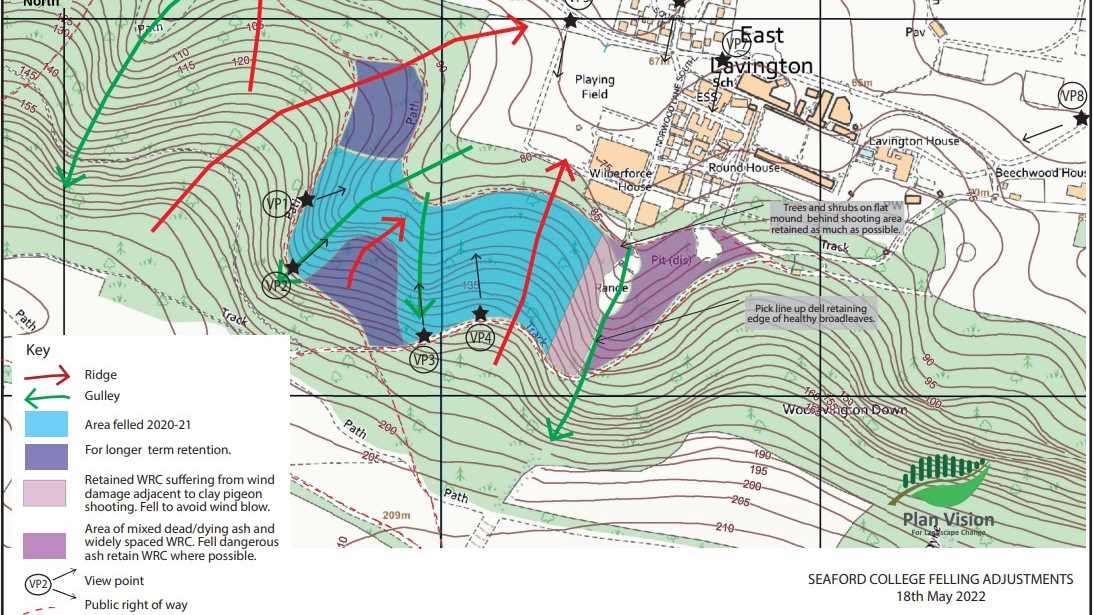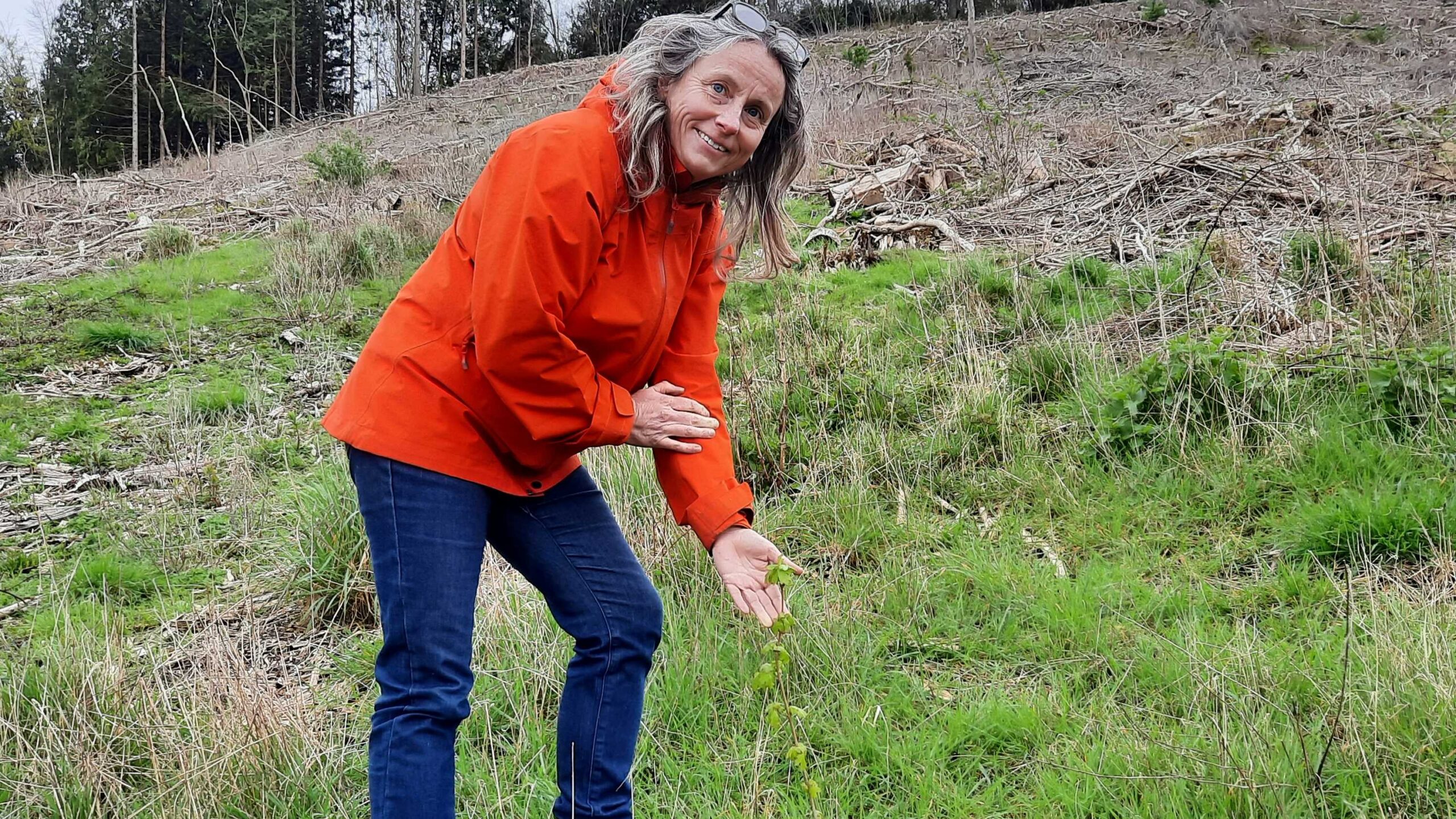Facing Up To A Steep Challenge
The re-stock of a woodland on the north facing slopes of the South Downs National Park came with some exceptional topological, landscape, biodiversity and deer browsing challenges.

Above: Laura Henderson of English Woodlands Forestry at the bottom of the steep escarpment
The 5.5ha block of Planted Ancient Woodlands Site (PAWS) woodland is owned by Seaford College, an independent co-ed school in West Sussex which has a strong environmental record and awards for its wildlife meadow.
Aims

Above: View from the top of the block after the original harvesting. Gradients are around 32 degrees. Credit: Roger Worthington, Plan Vision
The block had been planted with Western Red Cedar in the 1970s but fell out of management and become overstood. It was seen as a “biodiversity desert” that was potentially vulnerable to windblow.
The college, working with advice from English Woodlands Forestry, decided that the block should be felled and restocked with a mix of trees found elsewhere within the South Downs National Park.
This would add biodiversity, climate resilience and landscape enhancement. The nature of the steep slopes and chalky soil (gradients estimated to be 32 degrees) make it challenging for harvesting or managing timber crops.
The Western Red Cedar had been removed in two harvests in 2021/2022. English Woodlands Forestry successfully applied for 6,900 trees under our Grants for Resilient Woodlands.
Consultations

Above: Restock Plan: Credit: Roger Worthington, Plan Vision
The site is bounded at the top and the bottom by a public bridleway and is close to College sports and activities areas. The South Downs Way runs just south of the block and a power line runs along the western edge of the site.
The slopes are a very visual landmark within the College grounds and for nearby houses. Independent landscape architect Roger Worthington from Plan Vision was approached to consider the topology and develop appropriate landscape links.
South Downs National Park was consulted on species choice. They also provided additional funding for shrubs along the edges and 100 disease resistant elm trees.
Public consultations were held with the local community to explain the long-term benefits of felling and restocking. They were also consulted on species choice. In keeping with neighbourhood concerns, a fringe of spruce and other conifers has been retained below the access road until the new trees and ground flora have become sufficiently established to green the hillside.
Advice from Sussex Wildlife Trust led to the inclusion of field maple to create habitat for the rare Plumed Prominent Moth which has a limited population on these northern slopes.
Species Choice

Above: Regeneration of Western Red Cedar and other species is being encouraged alongside planted species
Soil is shallow and lime rich over flinty chalk. It is of medium-low fertility typical of the South Downs.
Gullies are seen as important opportunities for wildlife corridors for birds, butterflies, insects and chalkland flora and fauna.
The 12 species mix agreed under our Grants for Resilient Woodlands broadly replicates species found locally along these slopes. The Ecological Site Classification (ESC) was also consulted. The species planted under the grant included:
- Yew and juniper for habitat and evergreen interest
- Field maple to encourage the Plumed Prominent Moth. This is supplemented by Norway maple to add diversity for climate change resilience and as a species which may host similar species to field maple.
- Oak, hazel, guelder rose, hawthorn, rowan, hornbeam, beech and sycamore.
Trees were sourced from plant healthy supplier Cheviot Trees and have a known provenance.
Natural regeneration is being encouraged. Birch and Western Red Cedar regeneration has already been recorded. Other regeneration species may include ash which is wide spread locally but has been hard hit by Ash Dieback.
An option to undertake some supplementary group planting protected by tubes is being considered. This would allow smaller areas to benefit from more focused deer protection and weed control and to reinstate some species most affected by losses so far.
Planting and Maintenance

Above: Gullies have been feathered with native shrubs to encourage biodiversity
The trees were planted in 2022/2023 in rows that followed the contours of the slope and where the stony ground allowed. Spacing was approximately 2m with 2m between rows. This represents a density of approximately 1,400 ha. The challenges of the slopes meant that the higher slopes are less densely planted than lower reaches.
The site is too steep to deer fence. The visual impact of tree guards combined with the difficulty of safely installing them on such a steep slope made them unviable.
Instead, all trees were sprayed with Trico deer repellent before planting and then again when they began to flush in spring 2023. Some initial weed hooking was also carried out to give the trees a start.
Sample plots were recorded with a What Three Words location for ease of ongoing monitoring.
Trees were not planted within the gullies. Instead the gullies were feathered with shrubs supplied by the South Downs National Park. Gully floors were mulched and have been left to develop local ground cover and flora – providing links to the College’s nearby wildflower meadows.
Beat up Assessment

Above: Deer browsing has been extensive
A beat up assessment of the Grants for Resilient Woodlands trees and the additional elms and shrubs was carried out in November 2023. Survival rates were variable between sample plots ranging from 36% to 92% with an average of 70.5%.
Deer browsing is extensive across the site despite the application of Trico. Deer have ripped out many yew plugs. These have not survived. They have also extensively browsed all broadleaved species. Some have been so extensively damaged they may not survive at all. It is anticipated that overall success rate, taking into account tree browsing, may fall to 57%.
Deer Control

Above: Some saplings are thriving
Seaford College is a member of a National Parks deer consortium. Discussions are on-going to better control deer at a landscape level. In some areas, weeds are being retained to provide some shelter and cover for struggling saplings against the deer.
Natural Regeneration is expected to make up many of the gaps in tree survival areas. Further monitoring will be undertaken whilst deer management is prioritised. A further assessment is due to be carried out in autumn 2024/spring 2025 to determine the way ahead.
The elm trees provided by South Downs National Park have retrospectively been fitted with deer guards but continue to be browsed. Some enterprising deer have also found ways to remove and damage some of the guards.
A deer exclusion plot has also been retrospectively included to identify any benefits to ground flora.
Health and Safety
There were a number of challenges to working on such a steep site. The planting gang from Tomorrow’s Forests were consulted and they opted to plant in rows that worked across the contour.
The earlier felling and extraction works had had to be carried out during school holidays, to avoid overlapping with school outdoor activities nearby. Bridleway users had been made aware of hazards.
More Information
If you are interested in learning more about this project, please email us at rfshq@rfs.org.uk
Grants for Resilient Woodlands
Our Grants for Resilient Woodlands are funded by Train Hugger and Green The UK. They are open for applications from Royal Forestry Society (RFS) and Royal Scottish Forestry Society (RSFS) members all year round.
These grants are to help people plant trees that will survive and thrive into the future. Creating better, more resilient treescapes for our environment, for people and for the economy.



